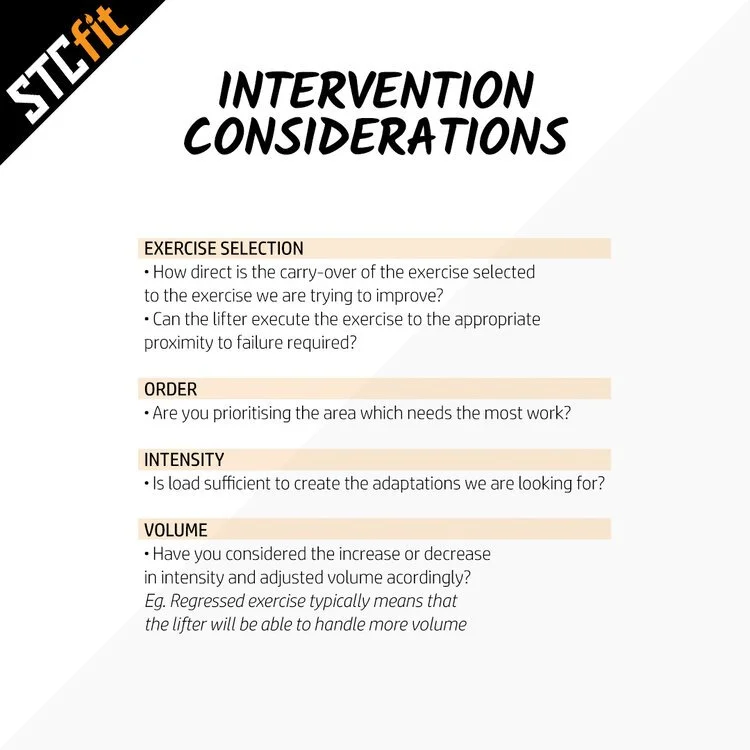Strength Breakdown Interventions
“Coaching Movement” - STCfit & Fox Physio, Part 3
The goal of this article is to build on from Part 1 (360 Degrees of Movement Assessment) and Part 2 (Why Your Lifts Break Down) and determine a potential intervention if a lifter is showing signs of a strength breakdown in technique.
Important things to remember:
Our definition of technique:
“Execution of a movement through a predetermined ROM with adherence to reference lines decided upon by an individual’s morphology, in accordance to the target outcome”
Our definition for a strength breakdown:
“Failure to adhere to the chosen technique brought on by load or rep fatigue”
Intervention Considerations
The main point of this article series is to allow lifters and coaches to make better choices when it comes to programming.
When creating a program the following should be staple considerations:
BACK TO ASSESSMENTS
Using the reference lines introduced in “360 Degrees Of Movement Assessment”, let’s look at a common strength breakdown in intermediate lifters, where the upper back rounds out of the hole.
Assessing the squat we see the following:
Side View →Does the thoracic spine remain neutral?
NO → Flexion created with a weight increase
Technique break down type → Strength
It is important to note the caveat mentioned in the previous article. These assessments provide us with clues, and point us in the right direction. They do not, however, provide a black and white answer.
Just because increasing load made the upper back round during the squat, it isn’t set in stone that the only issue here is strength. Increases in weight can make us forget basic cues — there is an inherent skill in handling more weight, bigger muscles produce more force and sometimes even improve positioning and mechanics. With this in mind, we approach the interventions with the intent to cover all bases.
For competitors, we need to look at times in a block where this would and wouldn’t be appropriate. But for most lifters, this approach will work into your regular volume allocation and programming method.
FLOW CHART OF INTERVENTIONS
Before we select exercises for a particular intervention, we need to understand the parameters in which best results are achieved for each.
Rehab Intervention
Exercise selection: Facilitate mobility, stability and strength.
Order: Typically movement prep. With increased load and intensity, can be integrated into the program via accessory allocation.
Intensity: Usually aiming for perfect execution of reps.
Volume: In the early stages, rehab is typically low load, high rep and high frequency. After this initial phase, the rehab will often be similar to that of strength interventions, starting at the lower end of the intensity range.
Strength Intervention:
Exercise selection: as close to goal movement as possible
Order: main lift of the program
Intensity: 80%+ 4–1RIR
Volume: replaces main lift volume allocation, potential increase due to reduction of fatigue demand, depending on the exercise selected
Movement Intervention:
Exercise selection: carry over to the main movement while challenging the specific area of breakdown
Order: programmed as accessory post main lift
Intensity: 40 to 80% 4RIR. Technical failure, not muscular
Volume: usual accessory volume allocation, higher volume ok due to low load and low proximity to failure
Hypertrophy Intervention
Exercise selection: target musculature involved in the breakdown area — typically done with the aid of external stability
Order: towards the end of the session
Intensity: 65–85% 2–1RIR
Volume: usual hypertrophy volume allocation
HOW IT MIGHT LOOK IN PRACTICE
Possible intervention ideas will be selected based on the aforementioned parameters, lifters preferences, available equipment, the overall goal of the mesocycle and more. We’ve selected some below that could be suitable in this situation.
Cueing = Push up into the bar / Wrap the bar around you back
Strength = Handle down SSB / Front Squat
Movement = Alternating bent over DB Row
Hypertrophy = Single Arm Cable Row / Reach pronate and supinate row
Treatment / Rehab = DB Pull Over Off Bench
APPLICATION TO PROGRAMMING
Once we’ve established the interventions that will aid the lifter to progress within each area, we can appropriately program.
A squat day for this individual may look something like this:
Remember, there are numerous ways to program for the same goal. You may choose to move different interventions across the week, depending on your preferred layout and frequency, but this should give you an idea of how to apply.
APPLY IT YOURSELF
Did you check out your lifts during the first two articles, as we suggested? If you found what appeared to be a strength breakdown, run through the reference lines, review the parameters and select one appropriate intervention per category that you could use. Identify the sets, reps and RIR you would select and design a training day focusing on that intervention.
As always, Laura and Ben look forward to your feedback on the series so far. We’ll be back next month with “Movement Breakdowns”.


